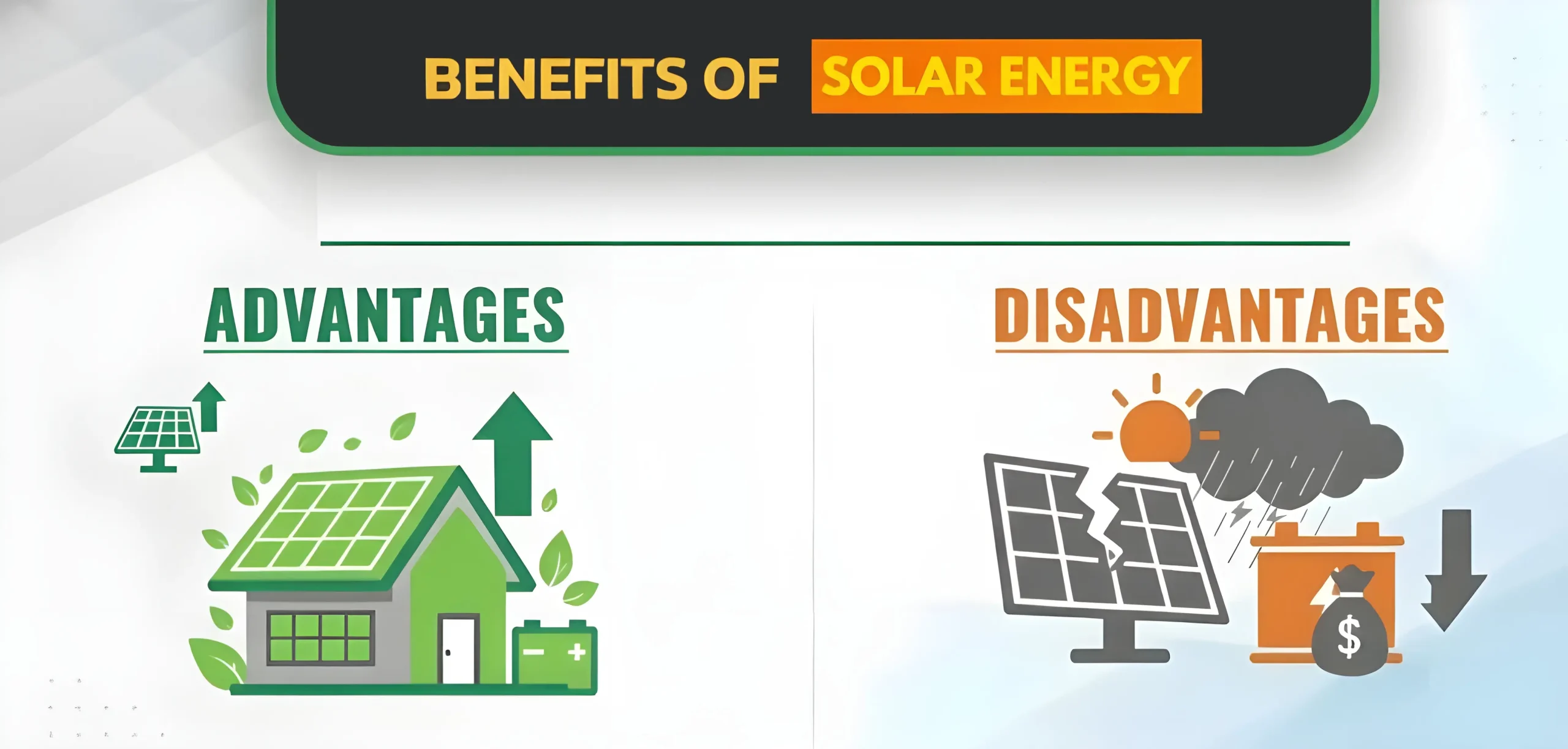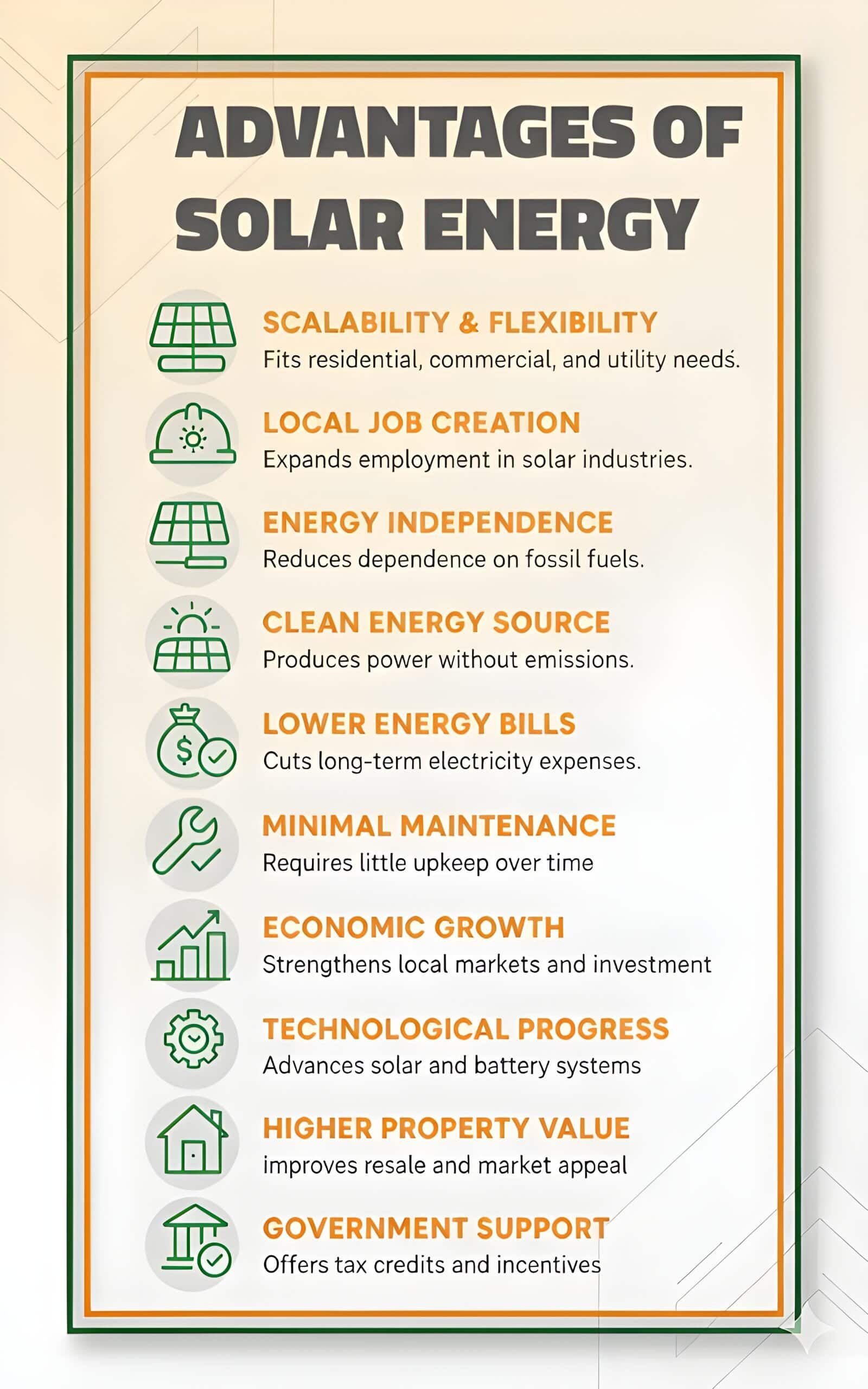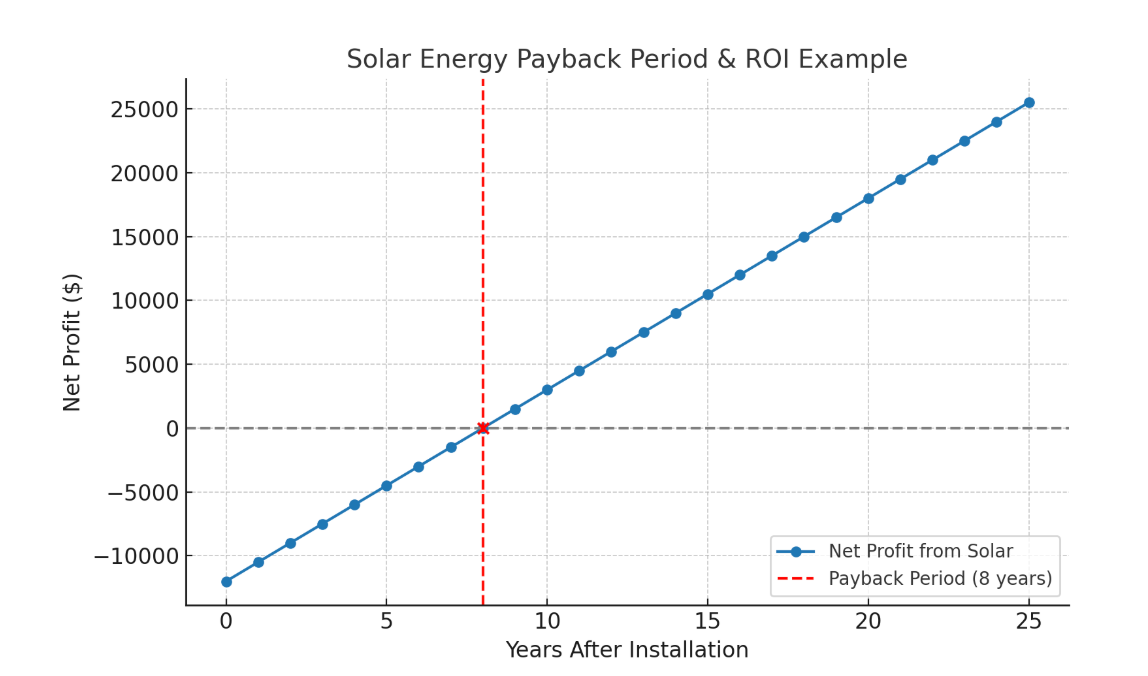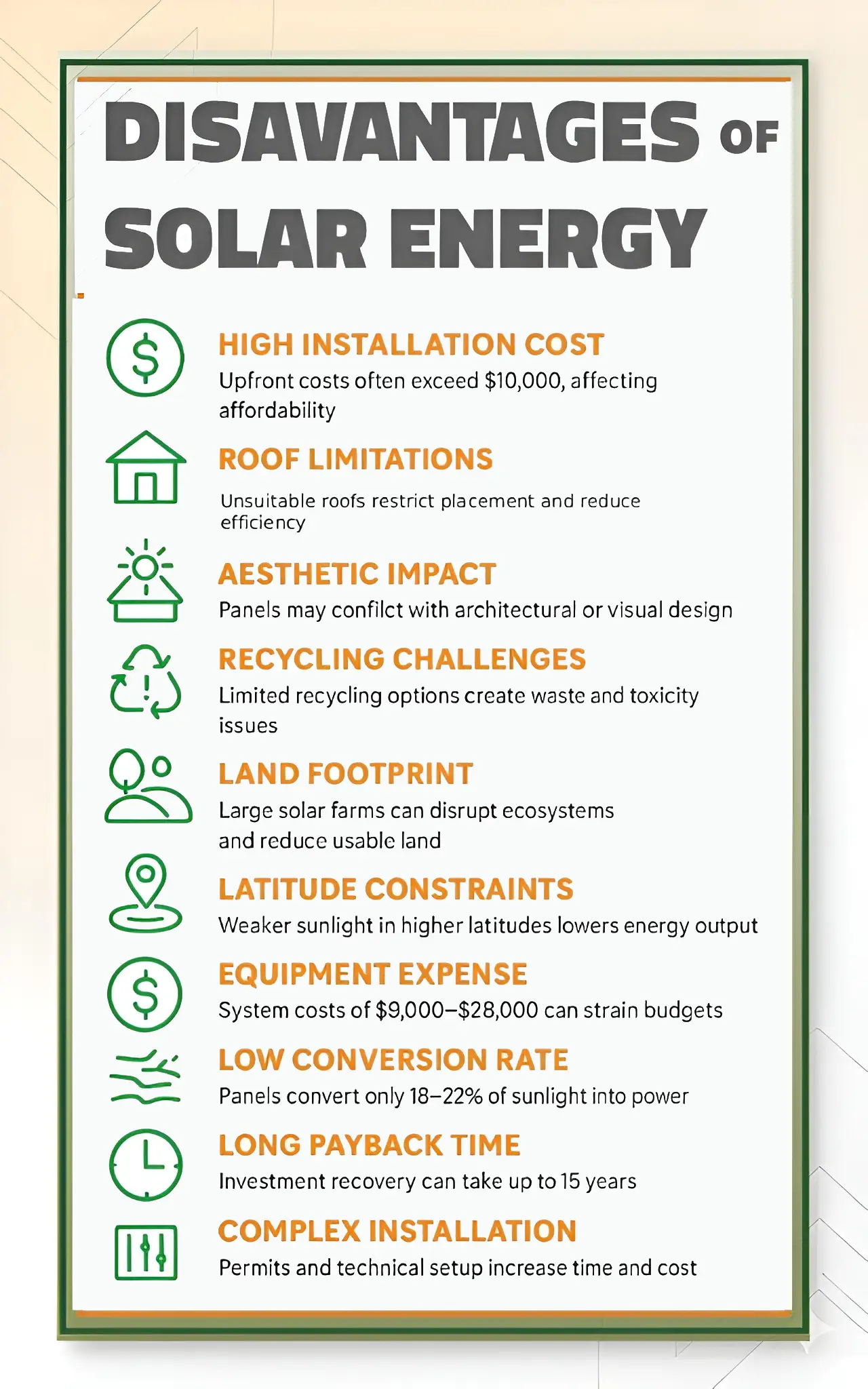
What Is a Solar Hot Water System? Solar hot water is a system that harnesses the sun’s energy to warm […]

Is Solar Energy Really Worth It? Let’s Break It Down!
With rising electricity bills and growing concerns about climate change, solar energy has become a popular alternative for homeowners and businesses alike.
But is switching to solar indeed the best decision for everyone?
While it promises clean, renewable power and long-term savings, it also comes with certain drawbacks.
In this article, we’ll dive deep into the advantages and disadvantages of solar energy to help you decide if it’s the right choice for you.
Let’s explore both sides of the coin!

One of the biggest benefits is the significant reduction in electricity bills, as generating your own power helps cut down or even eliminate monthly energy costs. With minimal maintenance required and systems lasting 20–30+ years, solar offers great reliability.
Additionally, installing solar panels can increase property value and make your home more attractive to buyers. Many governments also provide rebates and incentives, which reduce the upfront cost and make going solar more affordable. Here are the seven most crucial benefits of solar energy.
The benefits of using solar energy outweigh the drawbacks as most of the disadvantages have implementable solutions. Solar energy remains one of the best and cleanest energy sources.
Solar energy produces zero emissions during use, making it one of the cleanest and most eco-friendly power sources available.
Another main advantage of solar energy is that you can escape from high monthly electricity bills.
Once you have installed a solar power system, it operates for many years, with lifetimes of 25-30 years, and with very minimal maintenance.
The main advantage of owning a solar power system is that it gives the user direct ownership of electricity production without the need to pay fees.
This will also allow the user to calculate the exact amount of monthly and yearly energy usage.
Switching to solar can save you between 50% to 100% on your electricity bills. In Australia, the average household can save $1,000–$2,500 per year on electricity bills by going solar. Over 25 years, that adds up to $25,000–$60,000 in savings.
Another significant advantage of solar energy is that it requires very little maintenance. Maintenance of solar panels involves simple cleaning of the panel surfaces to remove dust, dirt and rubble.
Compared to other power generation sources that require extensive maintenance and parts inspection, solar maintenance is an easy, smooth task.
Solar energy installation can benefit the economy in a number of ways. First, the installation of solar panel systems helps reduce the amount of fuel imported from other countries, which tips the trade balance in favour of the local economy.
Second, it reduces the high importation and logistical costs of importing and transporting fossil fuels into the country and storing and transporting them safely.
Reducing the dependence on foreign countries gives citizens and governments much-needed control over the means to generate power. It effectively frees much-needed capital to be used in more essential industries.
Solar technology is constantly evolving, and continuous research promises further advancements in the future.
Quantum physics and nanotechnology advancements have the potential to increase the effectiveness of solar panels and double, or even triple, the efficiency and effective electrical output of solar power systems.
Another advantage of solar energy comes from significantly boosting your home’s market value.
Buyers are increasingly looking for energy-efficient homes with lower running costs, and solar systems offer exactly that. Studies show that homes with solar can sell faster and for more money compared to those without.
The promise of reduced electricity bills and sustainable living makes solar-equipped properties more attractive in today’s market. Plus, the long lifespan of solar systems (20–30+ years) adds long-term value to the property.
Eligible for Government Rebates
Another significant advantage of having solar energy is that you become eligible for a clean energy government rebate.
Switching to solar can be more affordable thanks to various government rebates and incentives. In many regions, homeowners can receive financial support through programs that reduce the upfront cost of installing solar panels.
For example, in Australia, the Small-scale Renewable Energy Scheme (SRES) provides STCs (Small-scale Technology Certificates), which can significantly lower installation expenses.
Some states also offer additional rebates or feed-in tariffs for excess energy sent back to the grid. These incentives make solar a smart, cost-effective investment with faster payback periods.
One of the most empowering benefits of solar energy is energy independence. The ability to produce your own electricity and rely less on external energy providers.
For decades, households and businesses have been tied to the grid, vulnerable to fluctuating electricity prices, unexpected outages, and fossil fuel shortages. Solar energy changes that equation entirely. By generating power directly from your rooftop, you’re taking control of your energy future.
In Australia, where electricity prices have soared over the past decade, going solar gives homeowners stability and peace of mind. With a solar-plus-battery system, you can store surplus energy during the day and use it at night or during blackouts, reducing dependence on the grid even further.
During extreme weather events or grid failures, both of which have become more common. They have a solar panel with a backup battery, which means your essential appliances keep running. You’ll have lights, refrigeration, and communication, while others may face outages.
Another overlooked but powerful advantage of solar energy is its job creation potential. The renewable energy sector, particularly solar, has become one of the fastest-growing job markets globally, and Australia is no exception.
According to the Clean Energy Council (CEC), the Australian renewable energy industry supports over 30,000 direct jobs, with solar PV accounting for nearly half of them. These roles include panel manufacturing, system design, installation, maintenance, sales, and engineering, offering opportunities across both urban and rural areas.
Unlike fossil fuel industries, which rely heavily on centralised extraction and transportation, solar energy creates distributed employment. This means jobs are generated locally where systems are installed. This boosts community economies, provides stable employment, and supports small business growth.
Moreover, the solar industry encourages skills development and innovation. Electricians, technicians, and engineers gain access to cutting-edge training and certifications, fostering a new generation of skilled professionals in sustainable technologies.
Unlike traditional energy systems that require massive infrastructure, solar energy is highly scalable. Actually means it can be designed to suit any size, purpose, or budget.
In case you are powering a small suburban home, a remote farmhouse, a school, or an industrial facility. Solar systems can be tailored to your specific energy needs. You can start small, with a few panels and expand later as your energy consumption or budget grows.
This flexibility also extends to system design. Solar can be installed on rooftops, carports, building facades, or open land. For off-grid properties in regional Australia, standalone solar systems with batteries provide full energy independence, eliminating the need for costly power line extensions.
Furthermore, technological advancements like microinverters and smart energy management systems allow for modular setups. These let homeowners monitor and control their energy production in real time, ensuring maximum efficiency and easy upgrades.
When you install solar panels, you pay an upfront cost, but then you generate free electricity for decades. The payback period is the time it takes for your energy savings to equal your initial investment. After that, the electricity you produce is essentially profit — your Return on Investment (ROI).
Example:
Result: You recover your cost in 8 years, then enjoy a 212% ROI over the system’s life.

While solar energy offers many benefits, it also comes with some disadvantages to consider. The most notable drawback is the high upfront cost of purchasing and installing a solar system, particularly with battery storage. Here we list the seven disadvantages of solar energy.
The main financial setback of solar is the high installation cost, which can often reach levels that make it impractical for homeowners with limited incomes, as it could sometimes cost more than the house construction cost.
The average price of installing effective solar panels ranges from $10,000 to $20,000. The cost of batteries can also be quite significant for solar power system users.
Solar panels are not suitable for all types of roofs, such as those made of slate or cedar tiles. Rooftop additions and skylights may also impede the installation and decrease the roof space that can be used for solar panels, thus decreasing the power that can be generated.
Although the installation of solar panels on some buildings adds to their beauty, this is not always the case. It is possible that the addition of solar panels to certain vintage or architectural buildings may reduce their aesthetic value.
The building’s final appearance might be of key importance to an owner refusing to compromise, even for the gain of free energy.

While solar panels are eco-friendly during use, their end-of-life disposal poses a challenge. Most panels last 25–30 years, and as early installations start reaching this age, millions of panels will require recycling or disposal.
The problem is that recycling infrastructure for solar panels is still limited and costly. Many panels contain materials like glass, aluminium, and silicon that can be reused, but also small amounts of toxic substances (e.g., lead, cadmium) that require careful handling. Without proper recycling systems, old panels risk ending up in landfills, creating electronic waste and environmental hazards.
This makes solar panel disposal a growing environmental concern that needs urgent solutions as the industry expands.
When solar panels can not be installed on rooftops, they tend to take up more land space and effectively, the amount of energy trapped tends to increase with the area of the solar panel.
The latitude dependence of solar energy refers to the fact that the amount of sunlight a location receives varies with its distance from the equator. This becomes a drawback because:
In short, the farther you are from the equator, the more unreliable and variable solar energy output becomes, often requiring larger panel arrays, better storage, or backup power sources to compensate.
A 6kW solar panel system for a 1,500 square foot home costs, on average $18,500 to install. The cost of solar panels per watt can range from $2.50 to $3.50, depending on the home’s geographical location.
Residential solar panels are typically 3kW to 8kW in size and can cost between $9,255 and $28,000 in total installation costs. See the average cost of a solar panel system by size (before tax credits or discounts).
Even with modern technology, solar panels convert only about 18–22% of the sunlight they receive into usable electricity.
This means most of the solar energy hitting your panels is not actually converted. Factors like dust buildup, shading, and panel angle further reduce this efficiency.
Although advancements are being made, current efficiency levels still limit total power output, especially on small rooftops.
The time it takes to recover your initial solar investment (known as the payback period) can vary widely.
In regions where electricity prices are lower or sunlight hours are limited, it can take 10–15 years before savings equal the upfront cost. This makes solar less attractive for homeowners planning to move within a few years or those living in low-tariff regions.
Installing a solar energy system isn’t as simple as mounting panels on a roof. It often requires permits, electrical upgrades, and roof assessments before approval.
This can delay installation by several weeks or even months, especially in urban areas with strict regulations.
Choosing the wrong installer or skipping proper assessment can also lead to wiring issues, leaks, or suboptimal panel placement, reducing efficiency and lifespan.